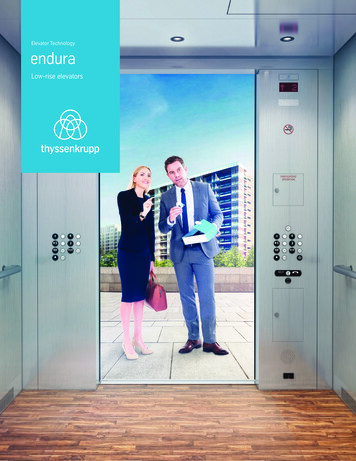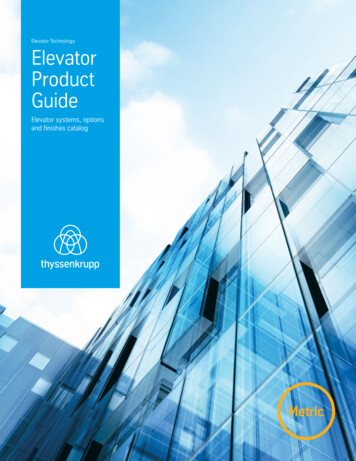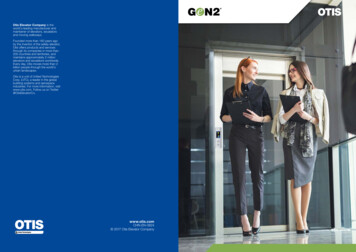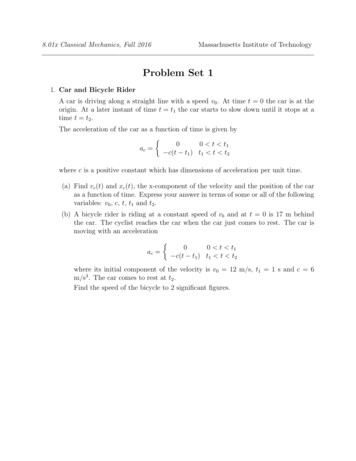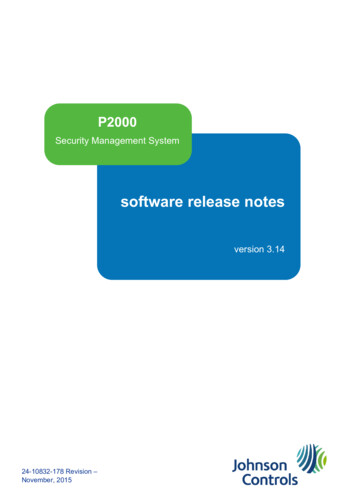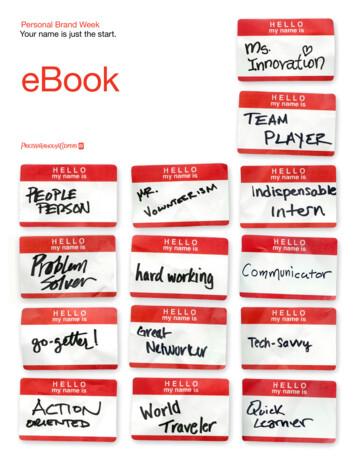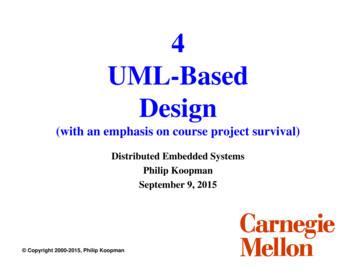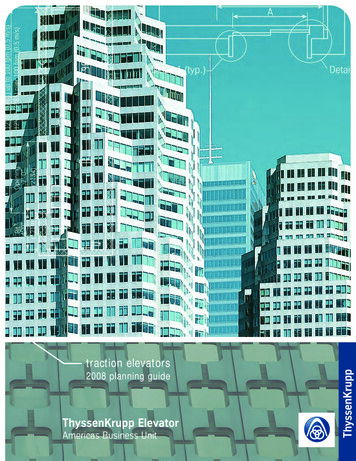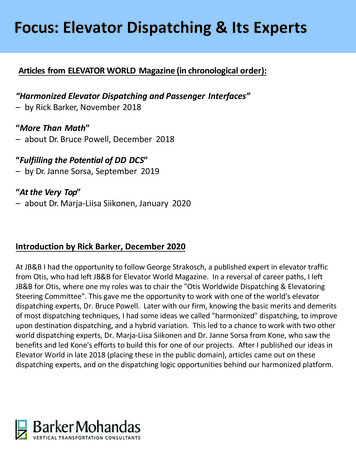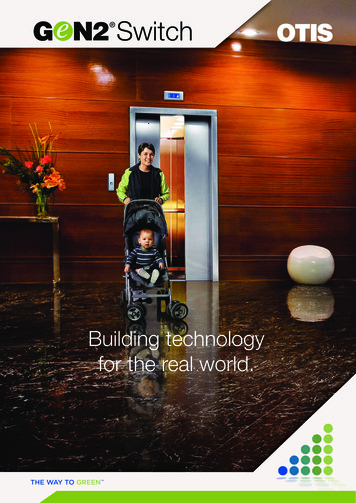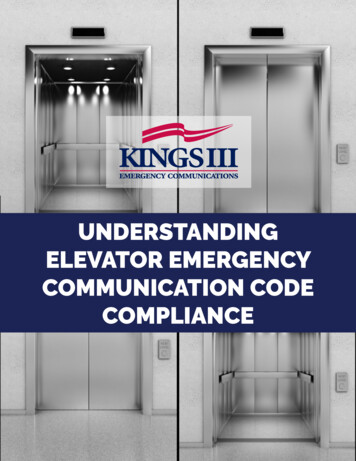
Transcription
UNDERSTANDINGELEVATOR EMERGENCYCOMMUNICATION CODECOMPLIANCE
INTRODUCTIONFew people think of elevator phones as part of a critical communication system and, as aconsequence, these phones are sometimes viewed as a nuisance by those that areresponsible for providing them. Because telecommunications is not a traditional area ofexpertise for elevator mechanics, phone issues can sometimes be misdiagnosed. Acommon remedy for phone trouble is to immediately replace the phone, which can berather costly. In other cases, the phone lines are considered the issue. This may notalways be the case.THE BAD NEWS:As much as you kick, scream and fight, you are required by law toprovide emergency phones in your elevators and with that comesa set of many codes that you must comply with and are liable for.THE GOOD NEWS:It doesn’t have to be that hard! We’ll walk you through the codesyou should be adhering to, phone line suggestions that complyand still save money and a quick and easy checklist to test youremergency phones to ensure that they’re working properly.Page 2 of 19
TABLE OF CONTENTSASME Codes You Should Know44Table: ASME A17.1/CSA B-44 Breakdown412Phone Line Sharing: Comply and Still Save413Phone Line Sharing the Wrong Way414Phone Line Sharing the Right Way415Cellular Solution417Test Your Emergency Phone- a Checklist418About Kings III419Page 3 of 19
ASME CODES YOUSHOULD KNOWReprinted from ASME A17.1-2019/CSA B44:19, by permission of The American Society of Mechanical Engineers. Allrights reserved.We will start with the most basic- the emergency communication code required of privateresidential elevators :American Society of Mechanical Engineers (ASME) A17.1-2019 Section 5.3.1.20Emergency Signaling Devices5.3.1.20.1 Two-Way Communication MeansA twoway communications means permanently installed in thecar shall be provided to summon personnel who can take theappropriate action 24 h each day. The two-way communicationsmeans shall not be transmitted to an automated answering device.If the normal power source for the communications means fails,the communications means shall automatically transfer to a sourceof standby or emergency power capable of providing service for atleast 4 h.5.3.1.20.2 Emergency Signaling DeviceAn emergency signaling device operable from inside the car and audible outside the hoistway shall be provided. The operating meansshall be labeled “ALARM” or with the appropriate symbol as definedin Table 2.26.12.1.If the normal power source for the emergency signaling device fails,the emergency signaling device shall automatically transfer to asource of standby or emergency power capable of providing servicefor at least 1 h.Page 4 of 19The purpose of thisrequirement is not so thatpassengers cannecessarily make phonecalls while they ride, butrather for the sole purposeof summoning help inthe event of entrapment.Often, cell phones do nothave service in elevators,so this is of utmostimportance.
ASME CODES YOUSHOULD KNOWReprinted from ASME A17.1-2019/CSA B44:19, by permission of The American Society of Mechanical Engineers. Allrights reserved.When it comes to commercial and other publicly accessible facilities (including multifamilyproperties), codes become more specific, and, consequently, can seem more complex. Here are theones you need to know:American Society of Mechanical Engineers (ASME) A17.1-2019 Section2.27 Emergency Operation and Signaling Devices2.27.1.1.1A communications means between the car and a location staffed by authorized personnel who cantake appropriate action shall be provided.Who is someone who can take “appropriate action”? To fulfill this law,whoever is staffed must be able to summon help to elevator, but whenyou’re thinking life safety, is this enough? Some additional items to consider:Can your operators provide medical instructions? Do they let you know whenan issue arises? Do they keep recordings of calls placed?2.27.1.1.2If the call is not acknowledged [2.27.1.1.3(c)] within 45 s, the call shall be automatically directed toan alternate on- or off-site location.Page 5 of 19
ASME CODES YOUSHOULD KNOWReprinted from ASME A17.1-2019/CSA B44:19, by permission of The American Society of Mechanical Engineers. Allrights reserved.2.27.1.1.3The communication means within the car shall comply with the following requirements:(a) In jurisdictions enforcing the NBCC, Nonmandatory Appendix E; in jurisdictions notenforcing the NBCC,ANSI/ICC A117.1, ADAAG, or ADA/ABAAG.(b) A push button to actuate the communications means shall be provided in or adjacent toa car operating panel. The push button shall be visible and permanently identified with thephone symbol (see 2.26.12.1). The identification shall be on or adjacent to the phonepush button. The communications means shall be initiated when the push button isactuated.Page 6 of 19
ASME CODES YOUSHOULD KNOWReprinted from ASME A17.1-2019/CSA B44:19, by permission of The American Society of Mechanical Engineers. Allrights reserved.2.27.1.1.3 (cont.)The communication means within the car shall comply with the following requirements:(c) *New in 2019: On the same panel as the phone push button, a message shall be displayedthat is activated by authorized personnel to acknowledge that communications areestablished. The message shall be permitted to be extin guished where necessary to displaya new message [see (d) and (e)] or when the communications are terminated.(d) *New in 2019: On the same panel as the phone push button, messages shall be displayedthat permit authorized per sonnel to communicate with and obtain responses from atrapped passenger(s), including a passenger(s) who cannot verbally communicate or hear.(e) *New in 2019: On the same panel as the phone push button, a message shall be displayedthat is activated by the authorized personnel to indiciate when help is on the way. Themessage shall continue to be displayed until a new message is displayed [see 2.27.1.4(c)]or the communications are terminated.What does this mean?The elevator must have the ability for authorized personnel to send messages to as wellas receive responses from trapped passengers. This includes passengers that cannotspeak or hear.An operator is onlineOperator: Kings III do you have an emergency?Passenger: YesOperator: Did the elevator door fail to open?Passenger: YesOperator: Press and hold down the Floor 1 orlobby button for 5 seconds. Did the door open?Passenger: NoPress Door Open for YESPress Door Close for NOHelp is on the wayPage 7 of 19
ASME CODES YOUSHOULD KNOWReprinted from ASME A17.1-2019/CSA B44:19, by permission of The American Society of Mechanical Engineers. Allrights reserved.2.27.1.1.3 (cont.)The communication means within the car shall comply with the following requirements:(f) The communication means shall provide on demand to authorizedpersonnel information that identifies the building location andelevator number.(g) The communications, once established, shall be disconnected onlywhen authorized personnel outside the car terminate the call or atimed termination occurs. A timed termination by thecommunications means in the elevator, with the ability to extend thecall by authorized personnel, is permitted if voice notification is sentby the communications means a minimum of 3 minutes aftercommunication has been established. Upon notification, authorizedpersonnel shall have the ability to extend the call; automaticdisconnection shall be permitted if the means to extend are notThis is a big overlookedenacted within 20 seconds of the voice notification.(h) The communications means shall not use a handset in the car.(i) The communications shall not be transmitted to an automatedanswering system. The call for help shall be answered byauthorized personnel.(j) Operating instructions shall be incorporated with or adjacent to thephone push button.one: Many answeringservices are automatedto have the systemanswer, press 1 forthis, 2 for that, etc.orput callers in a queuewaiting for the nextavailable operator.Code states this is notacceptable.(k) *New in 2019: A means to display video to observe passengers at anylocation on the car floor, to authorized personnel for entrapmentassessment, shall be provided.What does this mean?The elevator must have video capabilities for the authorized personnel to view the entirefloor of the elevator cab for in the event that they cannot hear a passenger or if thepassenger is unable to speak.Page 8 of 19
ASME CODES YOUSHOULD KNOWReprinted from ASME A17.1-2019/CSA B44:19, by permission of The American Society of Mechanical Engineers. Allrights reserved.2.27.1.1.4Where the elevator rise is 18 m (60 ft) or more, a communications means within the buildingaccessible to emergency personnel shall be provided and shall comply with thefollowing requirements:(a) The means shall enable emergency personnel within the building to establishcommunications to each car individually. The communications shall be established withoutany intentional delay and shall not require intervention by a person within the car. Themeans shall override voice communications to outside of the building.(b) The communications, once established, shall be disconnected only when emergencypersonnel terminates the call or a timed termination occurs. A timed termination by thecommunications means in the elevator, with the ability to extend the call by authorizedpersonnel, is permitted if voice notification is sent by the communications means aminimum of 3 minutes after communication has been established. Upon notification,emergency personnel shall have the ability to extend the call; automatic disconnectionshall be permitted if the means to extend are not enacted within 20 seconds of thevoice notification.IN ENGLISH, PLEASE? Calls must be answered by live personnel. If travel exceeds 60 ft., an accessible phone onsite must be available for emergencypersonnel to speak with the elevator passengers. Phone must be able to break into existing elevator phone calls. If a call is connected to anoffsite answering facility the lobby phone must be able to join in the conversation. Phone must be able to select which elevator(s) to connect to. The elevator phone must automatically answer inbound calls. You must be able to callback in to the elevator and the phone must automatically answer.Page 9 of 19
ASME CODES YOUSHOULD KNOWReprinted from ASME A17.1-2019/CSA B44:19, by permission of The American Society of Mechanical Engineers. Allrights reserved.2.27.1.1.4 (cont)Where the elevator rise is 18 m (60 ft) or more, a communications means within the buildingaccessible to emergency personnel shall be provided and shall comply with thefollowing requirements:(c) *New in 2019: Once the communications have been established, amessaged shall be displayed on the same panel as the phone pushbutton, that is activated by the emergency personnel to indicatethat help is on-site. The message shall be permitted to beextinguished where necessary to display a new message [see (e)]or when the communications are terminated.(d) Operating instructions shall be incorporated with or adjacent tothe communications means outside the car. Instructions shallconform to 2.27.3.Page 10 of 19Why is this important?Currently, manyelevators only have alight to indicate thathelp is on the way. Thenew indicator willprovide clarity andadditionalreassurance to theentrapped passenger.
ASME CODES YOUSHOULD KNOWReprinted from ASME A17.1-2019/CSA B44:19, by permission of The American Society of Mechanical Engineers. Allrights reserved.2.27.1.1.4 (cont)Where the elevator rise is 18 m (60 ft) or more, a communications means within the buildingaccessible to emergency personnel shall be provided and shall comply with thefollowing requirements:(e) *New in 2019: On the same panel as the phone push button, messages shall bedisplayed that permit emergency personnel to communicate with and obtainresponses from a trapped passenger, including a passenger who cannot verballycommunicate or hear.Why is this important?This provides additional support to those passengers who are speech or hearing impaired.(f) *New in 2019: A means to display video to observe passengers at any location on thecar floor, to emergency personnel for entrapment assessment, shall be provided.Why is this important?A video feed into the cab provides emergency personnel with additional information tobetter assess the situation. This includes verifying whether a passenger is unconscious,simply nonverbal or perhaps the call is a false alarm, and there is no one in the elevator.Page 11 of 19
ASME CODES YOUSHOULD KNOWKings III Equipmentis also designed tobe ADA and IBCcompliant.We get it-- that’s a LOT of information at once. TLDR? Here’s a table that breaks down therequirements of ASME A17.1/CSA B-44 showing all versions dating back to 2000. Refer to the yearyour state follows to determine what you must do to be code compliant. Not sure which year yourstate requires? Learn here.20002004/20072010/2013/20162019Two-way communication between elevator & authorized personnel Machine room communications if over 60 ft of travel Answer by live authorized personnel- no automated answering Communication capability for onsite authorized/emergency personnel On-site monitoring if staffed 24/7 by authorized personnel Location identification on demand to authorized personnelLocation identification without voice communication A Hands free devices only (handsets not approved) Automatic answer when calling into elevator Automatic redirect if no answer onsite (ADA compliance date 1994)Offsite communications shall not interfere with on-site communicationsLocal telephone line status monitoring and local alertTwo-way message display in cab for hearing and/or speech impaired Means for authorized personnel to view video of passengers anywhere in cabMeans activated by emergency personnel to change cab message to indicatehelp is on-site if over 60 ft of travel Automatic redirect if no answer onsiteA Required by ADAPage 12 of 19 Only if remote machine room(2.7.8.4)
PHONE LINE SHARING:COMPLY AND STILL SAVEMany people resent elevator codes because they believe that it brings with it more hassle andmore cost. In fact, a common industry practice cuts corners and operates all elevator emergencyphones from a single phone line using line sharing in order to avoid additional costs and labor. Thisis a dangerous practice and is not code compliant. However, there is a way to avoid thesedrawbacks and still meet code. Let’s take a look:Page 13 of 19
PHONE LINE SHARING:COMPLY AND STILL SAVEPhone Line Sharing the Wrong WayTELEPHONE LINE SHARINGCommon Industry PracticeSINGLE PHONE LINESimply connecting multipleemergency phones to a singlephone line: Sacrifices reliable performance forperceived cost savings. Does not meet the intent of A17.1for any year since 1978.Activating phones on a sharedphone line can:Problem: Fails ASME and ADA because all phones will notwork simultaneously. One phone off-hook preventsremaining phones from operating properly, often blockingcalls completely.Operator cannot call back into individual elevators. Whenmultiple elevator phones are in use, operators may not beable to play location message. Block other emergency calls Cause connected calls to disconnect Prevent retrieval of ADA requiredlocation informationA single malfunctioning phonecan disable all phonesattached to the shared line.In its simplest form, an elevator phone is connected to a dedicated phone line and is used to call“Authorized Personnel” when help is needed. Sounds simple enough but in many instances, real worldapplication is different. Customers don’t want to pay for phone lines that are seemingly almost never usedand certainly not one for every elevator in their building. So, some elevator maintenance companies cave into this customer resistance and wire all of the phones to the same line (line sharing). You may ask yourself What could be wrong with that? Everything!For starters, there is often not enough phone line current to support multiple emergency phones in usesimultaneously. Remember the past- what happened when you put one too many phone extensions in atyour house? The ringers quit working and voice volume decreased. Modern hands free phones experiencethose same problems but because they are full of electronics, you won’t always get a degradation ofperformance. Instead, the phone simply won’t work. This is unacceptable and causes blocked calls,disconnected calls, and blocked location information.Page 14 of 19
PHONE LINE SHARING:COMPLY AND STILL SAVEPhone Line Sharing the Right WayTELEPHONE LINE SHARINGThe ASME, ADA Code Complying Kings III SolutionSINGLE PHONE LINEKINGS III CONSOLIDATING DIALERWith Kings III’s smart dialer, all phone callsconsolidate to enable simultaneous two-waycommunication between each elevator caband our monitoring station. As each phone isactivated, it sends an identifying signalallowing our operators to locate each calleras ADA requires.Should phone line sharing ever be acceptable? Yes it should, but only when you are certain thatappropriate hardware is in place to support multiple phones in use simultaneously. Several companies,including Kings III, offer this. Contrary to mainstream opinion, elevators don’t have to have individualdedicated phone lines to be code compliant. Line sharing works, is cost effective and is code compliant ifdone properly.Proper line sharing requires a consolidation unit so multiple emergency phones can share a single phoneline and still operate simultaneously. This solves the blocked calls issue.Page 15 of 19
PHONE LINE SHARING:COMPLY AND STILL SAVEPhone Line Sharing the Right WayQuestions to ask when using a consolidator:p Can it share the line with other elevator equipment such as the modemsfor remotely monitoring elevator performance?p Does it have the ability to seize a “non-emergency” phone line for use byemergency phones?p Can a secondary line be connected as back-up should the primary lineever fail?Don’t use landlines? You can still save while using a codecompliant cellular emergency phone solution. Readabout ours in the next section.Page 16 of 19
CELLULAR SOLUTIONHow does Kings III’s Skyline cellularservice work?120 VACPowerAdapterSkyline completely eliminates dependency on POTSlines (Plain Old Telephone Service) by leveraging themobile network.For elevators, our solution uses a traditional ADAcompliant handsfree phone in each elevator cab.The cellular transceiver is located outside of theconcrete & steel-lined shaft.PowerCellular TransceiverSIMTraditionally our Skyline cellular unit is placed ina telco room. When necessary, we will installelsewhere on site to achieve a better signal solong as there is a power outlet available.Skyline utilizes existing wiring in the building(typically between the telecom room and/ormachine room and then through the travelcable into the elevator cab) to connect thecellular transceiver to the elevator cab.AntennaKings III Consolidator(Located in the Machine Room)12VElevator Cabs112 Volt Battery1.3AHSLA1005Kings IIIPhoneKings IIIPhone23Kings IIIPhoneCUSTOMER STORY: Extra Space Storage Future ProofsEmergency Telephone Solution.READ HERE.Page 17 of 194Kings IIIPhone
TEST YOUR EMERGENCYPHONE- A CHECKLISTEven if phone lines are code-compliant, there is always the possibility of a malfunction, so testingthem routinely is essential. While this can seem tedious, it doesn’t have to be time consuming. Theeasiest way to test your elevator involves two testers. If only using one tester, be sure to lock out oneelevator. Follow this quick and easy checklist to ensure elevators are Americans with Disabilities Act(ADA), ASME and International Building Code (IBC) compliant:p Activate at least two elevator phones at approximately the same time to test thateach phone in use at the same time is able to carry on a two-way conversation withemergency operator(s).This part of the test failed if:- Only one or none of the calls go through- One call connects but disconnects once 2nd phone is activated- The phones will not dial out- The calls can be completed but the parties cannot hear each otherp Ask the operator to identify your location and cab numbers, as required by ASME.This part of the test failed if:- The operator cannot ID the elevator without aid from the caller.p Call from the emergency responder phone (generally located at a guard station onthe main egress level or in the fire control room) to test the on-site emergencyresponder’s ability to call directly back to the elevators without intentional delay.This part of the test failed if:- The elevator phones cannot be called back directly.Once all aspects of this simple test are passed, you can be assured your elevator emergencycommunications system is both working properly and is code compliant. NOTE: If your statefollows ASME A17.1-2019, see here for additional items to test.Page 18 of 19
ABOUT KINGS IIIWho We AreKings III Emergency Communications has been providing complete, compliant and affordableemergency phone solutions for elevators, poolside, stairwells, parking areas and more for over 30years. Our all-inclusive solution includes equipment, installation, maintenance and 24/7monitoring at our very own Emergency Dispatch Center for one low price.Two of our key differentiators include our smart line seizure technology which eliminates costlydedicated emergency phone lines and our digital recording and storing of all calls. These coupledwith advanced operator training and many other value-added benefits allow us to reduce risk,liability and costs for our customers. We are designed, assembled and supported in the USA.Learn more at www.kingsiii.com.Browse more Kings III guides HERE.Get a free property assessment HERE.We’ll help you identify opportunities for emergency telephone costsavings and understand the code requirements for your property.Page 19 of 19
5.3.1.20.1 Two-Way Communication Means A twoway communications means permanently installed in the car shall be provided to summon personnel who can take the appropriate action 24 h each day. The two-way communications means shall not be transmitted to an automated answering device. If th
